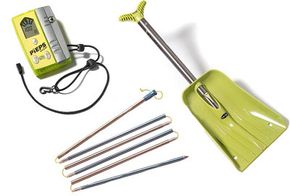Surviving an Avalanche: If You're a Witness
If you see someone swept away in an avalanche, you are their best hope for survival. Some ski areas do have search and rescue teams as well as rescue dogs, but going for help can take longer than the victim can survive. According to accident statistics, 92 percent of victims survive if their party digs them out within 15 minutes. Only about 25 percent survive after 45 minutes [ref]. Large groups can send someone for help, but small groups and individual survivors should not leave the scene unless help is just a few minutes away. Some experts say that lone survivors should conduct the search themselves. Others say that if the only survivor has no visual clue about the victim's location and if the victim or survivor was not wearing a beacon, the survivor should go for help.
If you see an avalanche overtake someone, you should:
Advertisement
- Watch him closely without looking away.
- Keep your eyes fixed on the last point at which you saw him if he becomes completely buried.
- Wait a minute or so after the avalanche stops for the snow to settle. Evaluate the risk of another avalanche. If one seems likely, have someone keep watch while you search for the victim.
- Conduct an efficient search.
Everyone who goes into the backcountry should have an avalanche rescue beacon, an avalanche probe and a shovel. These three items are central to any search and rescue operation.
- An avalanche beacon is a small transceiver. When an avalanche occurs, survivors switch their beacon from "transmit" to "receive" and use the signal to locate the victim. New beacons display the direction of the signal as well as its strength, but educators recommend that people practice locating buried beacons before going into avalanche territory.
- Avalanche probes are 10'-12' poles that collapse into segments that are about 2' long. They allow you to find solid objects buried in the snow. Some ski poles have removable grips and baskets and can also function as probes.
- Shovels are a basic necessity for digging out buried survivors. Avalanche snow is very solid, and digging with a shovel takes far less time than digging with your hands.
You can conduct your search using a variety of methods, as long as it covers all of the terrain in which the victim can be buried and works within the beacon's effective range. If you are with a large group, you can stand shoulder to shoulder and work your way down the slope, beginning at the point where you last saw the victim. Smaller parties and lone survivors can zigzag down the slope.
The closer you get to the victim, the stronger the signal will be. When you find the victim, dig him out quickly. Clear his airway and perform CPR or artificial respiration if necessary. Treat for hypothermia and shock, and get help as quickly as possible.
For lots more information about snow and avalanches, check out the links below.
Related Articles
More Great Links
Sources
- "Avalanche!" NOVA Online, 1997. http://www.pbs.org/wgbh/nova/avalanche/
- "Avalanche Awareness." National Snow and Ice Data Center. http://nsidc.org/snow/avalanche/
- Avalanche Library Project. WestWide Avalanche Network, 2005. http://www.avalanche.org/~moonstone/
- Avalanche Research Publications. Applied Snow and Avalanche Research, University of Calgary, October 2005. http://www.eng.ucalgary.ca/Civil/Avalanche/papers.htm
- Birkeland, K., et al. "Near-Surface Faceted Crystals: Conditions Necessary for Growth and Contribution to Avalanche Formation, Southwest Montana, U.S.A." Gallatin National Forest Avalanche Center, 1996. http://www.mtavalanche.com/articles/art2.htm
- Brugger, H. and M. Falk. "Analysis of Avalanche Safety Equipment for Backcountry Skiers." Austrian Association for Alpine and High Altitude Medicine, 2002. http://www.abssystem.com/abs-Dateien/main-Dateien/downloads/brugger_falk_report_2002%20_%20e.pdf
- Clayton, Mary. "Faceting." Canadian Avalanche Centre, January 26, 2005. http://avalancheinfo.net/Newsletters%20and%20Articles/Articles/Faceting.pdf
- Cyberspace Snow and Avalanche Center http://www.csac.org/
- Falk, M., et al. "Avalanche Survival Chances." WestWide Avalanche Network, 2001. http://www.avalanche.org/~moonstone/rescue/avalanche%20survival%20chances.htm
- Frequently Asked Questions. Friends of Utah Avalanche Center. http://www.avalanche.org/~uac/ed-faq.htm
- Gallatin National Forest Avalanche Center http://www.mtavalanche.com/
- Glossary: Snow and Avalanches. European Avalanche Forecasting Services. http://wa.slf.ch/index.php?id=278
- Hoffman, Nick. "Avalanches and Avalanche Deposits." University of Melbourne, 2002. http://www.earthsci.unimelb.edu.au/mars/Avalanche.html
- Johnson, R. and K. Birkeland. "The Stuffblock: A Simple and Effective Snowpack Stability Test." Gallatin National Forest Avalanche Center, 1996. http://www.mtavalanche.com/articles/art1.htm
- "Ready, Aim, Fire!" Linde Gas, January 11, 2004. http://www.linde-gas.it/International/Web/LG/IT/likelgit.nsf/docbyalias/kh_2004_01_11
- Snow and Avalanche Glossary. Cyberspace Snow and Avalanche Center. http://www.csac.org/Education/glossary/
- Snowgripper http://www.snowgripper.at/index_en.php?site=snowgripper.htm
- Terdiman, Daniel. "Taming the Wild Side." Wired News, January 24, 2005. http://www.wired.com/news/planet/0,2782,66360,00.html
- USDA Forest Service Northwest Weather and Avalanche Center http://www.nwac.noaa.gov/
- Williams, Knox. "Eight Steps to Reducing your Avalanche Risk." Colorado Mountain Club, March 1996. http://www.cmc.org/cmc/eightstp.html
